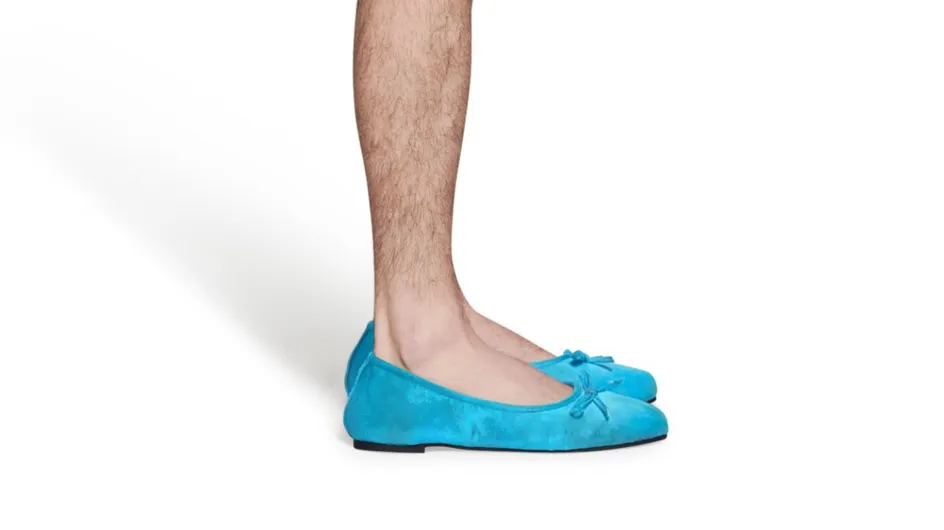
Love, hate, recontextualize. Almost a century after their birth, they continue to cause a stir. This time the sensation is more resounding, because the flats in question are signed by Balenciaga and are for men.
Worn on the most famous stages in the world, from Vaclav Nizhinsky to Rudol’f Chametovich Nureev, from Baryšnikov to Roberto Bolle, the ballet flats were born as genderless footwear for the world of dance, then taken out of context in the 50s for Brigitte Bardot by Madame Rose Repetto , who created the Cendrillon prima ballerina to be worn off stage, during leisure time. For this Spring Summer 2023, Balenciaga has them paraded at the feet of the models in a location covered in mud and contaminates them, dirties them, destroys them, to once again break gender stereotypes.
The Leopold dancers
After the last few months that have not been so serene for the maison, thrown into the spotlight for a decidedly non-politically correct campaign, Balenciaga is once again in the spotlight for the launch of the Leopold shoes. They are named after Leopold Duchemin, a collaborator of Demna, who, as he himself reported, consciously played with gender models to arouse reactions among users. Already available in the store, they are produced in fine satin, worked by Tuscan master craftsmen. They come in three color variants (black, turquoise and beige) and have a charming bow on the rounded tip, like the most classic women’s flats. Those Balenciaga presented on the catwalk have a distressed and lived-in look, almost a little shabby, to recall the deliberately destroyed sneakers, also present in woven leather, slightly more aggressive than the satin with an opaque finish.
Standardization proposal
It is not surprising that some discussions have been triggered: the ballerinas are the most debated footwear in history and even among the female public the consensus is never unanimous. What gives rise to the controversy, some supporting it with enthusiasm and some denigrating it, is Demna’s will to intervene periodically on the pre-established styles of a stylistic code that no longer reflects reality and which follows rules that do not embrace the total freedom of being . Her approach is definitely unconventional and dystopian, but it doesn’t seem to be a provocation, but a proposal for normality and normalization: everyone is free to wear what they want, even accessories and clothes that have long belonged only to the female wardrobe. This is how she sums up her choices about herself: “I hate boxes and I hate labels and I hate being labeled and put in a box. Society, the internet and the world at large love to do this, because it feels safe this way. You need to have courage and tenacity to truly assume your identity and who you really are.”
Imaginary borders and inclusive brands
Demna at Balenciaga is not the only one to feel the need to create new stylistic codes, since there are many brands that in recent times offer irreverent collections towards imaginary borders, supposed and placed as the demarcation line between men and women. Among the first to create a men’s ballet flat, in chronological order, is Dries Van Noten, who introduced men’s ballet flats on the catwalk for his SS15 collection, followed by Alessandro Michele for the SS 2016 at Gucci. The ability to make his collections conceptual and profoundly innovative dialogues was a typically Michelian dexterity, always above the standards and beyond the certainties of the right-thinking, but probably so dignified and sentimental as to be his own condemnation. After him also Jil Sander for the SS20, as well as Miu Miu for the FW22 and Maison Margiela and Comme Des Garçons, which for the SS2023 contributed to the trend with two models, respectively in the Tabi and square-toe version. Converging and reinforcing the Balletcore aesthetic, Harry Styles was among the first to choose Molly Goddard dancers for the look of the cover photo of the Harry’s House album.
Men’s ballet
Boosted by the Balletcore trend, which has been going viral for a few seasons, flats, flat shoes to show off without commitment, become the definitive must-have for the city. If initially the dance revolved around a male figure, defined as a danseur noble, since the time of the French Revolution the dancers have been victims of prejudices that have progressively made them marginal. Consequently, in order to perpetuate and preserve the canons of absolute male virility, ballet costumes also focused mainly on female figures, relegating this discipline, for a long time, to a predominantly female activity. However, at the beginning of the 1900s, the exotic charm of the Ballets Russes, brought to Europe by Sergei Diaghilev and dancers such as Vaclav Nizhinsky, shaped dresses with fluid and soft lines, which in a short time also made inroads into the women’s fashion of the time, heralding the dialogue towards a genderfluid fashion. Today, numerous brands, which assume the responsibility of capturing the contemporary, turn their stylistic choices towards a fashion that is, at least apparently, more inclusive, and which offers, to those who wish, to break down the barriers between menswear and womenswear.
Right-thinking people condemned them a priori, with the same attitude used for any other novelty of this kind. Not for their aesthetics, which could objectively be unpleasant to the eye, but for the concept that these flats contain. To criticize its image, numerous Tik Tokers, who align themselves with the historical accusations made against this shoe, which has always aroused love and hate, be it male or female. Flats may not be the perfect shoes to show off, but once again they pose a question to us: who really has the power to judge our tastes? From the time of Julius Caesar, testified by Plutarch, we have been given a maxim: de gustibus non est disputandum.
